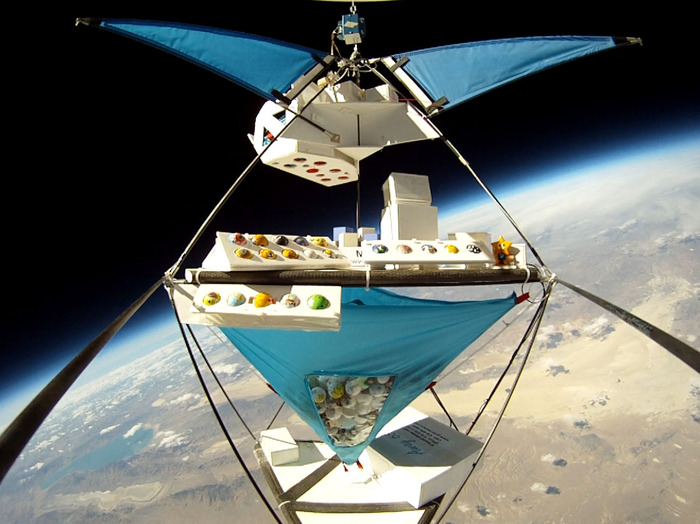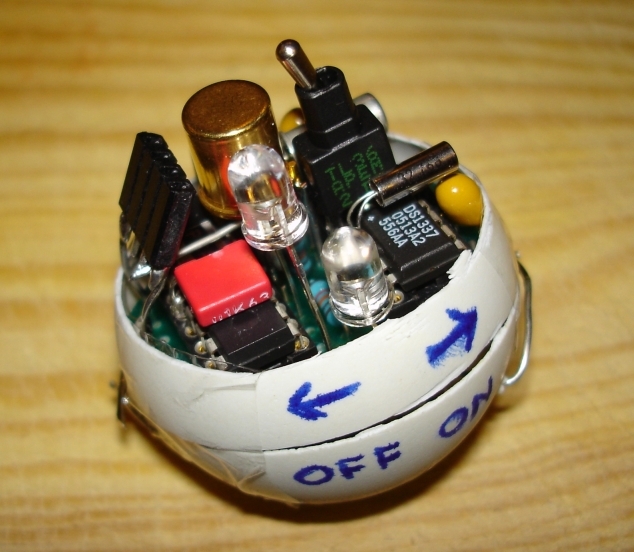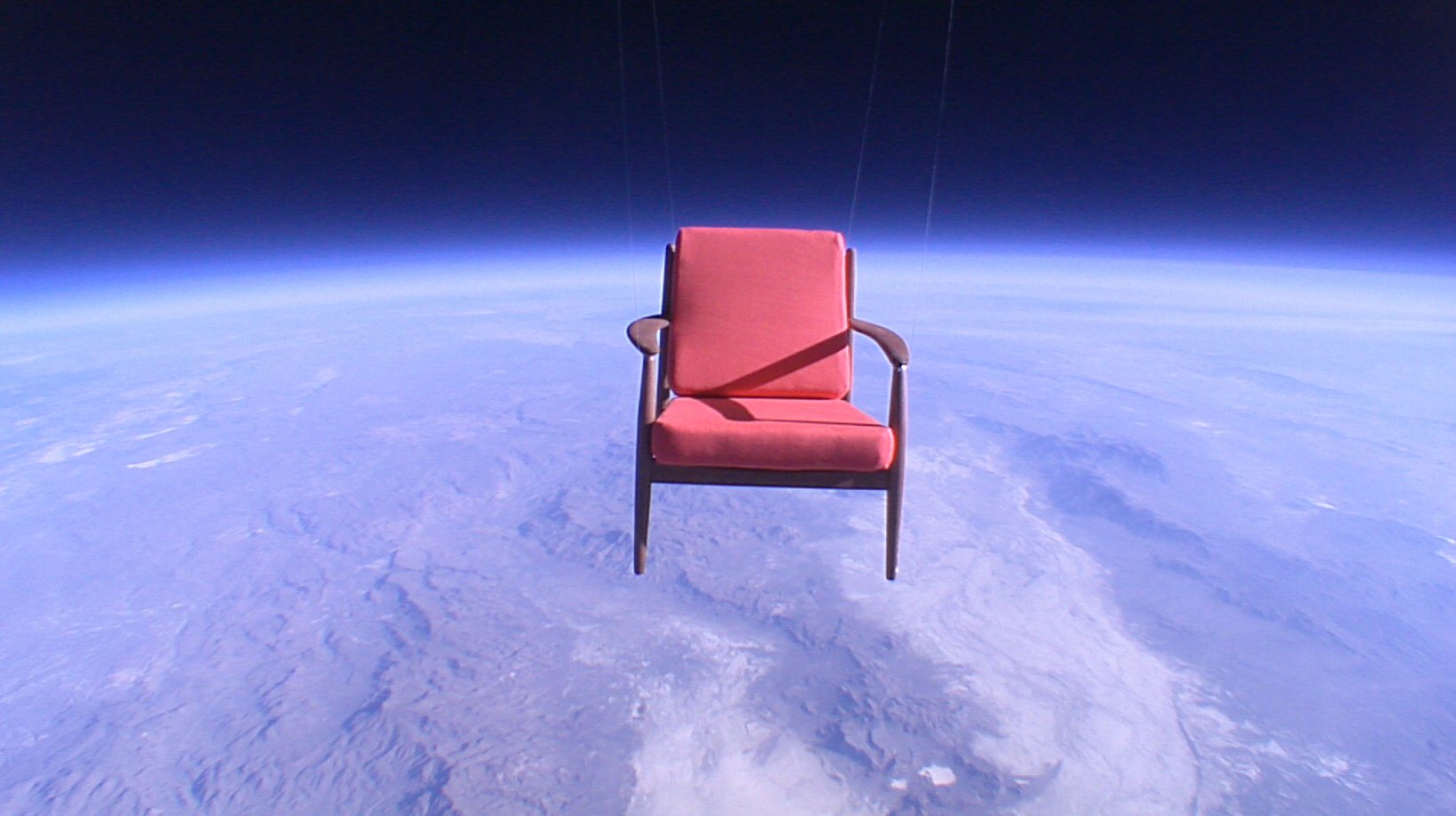Ping Pong Ball 'Satellites' Have Balloon Ride to Edge of Space

A do-it-yourself space program is gearing up to return to the edge of Earth’s atmosphere, floating above the world and the boundary between sky and stars.
All manner of payloads, a majority of them contained in ping pong balls (dubbed PongSats) created by students from all over the globe, will be carried by a series of weather balloons later this month.
“This mission is getting pretty huge,” said John Powell, president of JP Aerospace in Cordova, Calif. “We’re flying 1,600 PongSats, six MiniCubes, three high-altitude advertisements, two TV commercials and three weddings! Not actually weddings, but proposals … a dedicated ring-bearing vehicle and another set of rings and wedding favors.”

Seven vehicles are to be let loose Sept. 29, five of them to 100,000 feet (30,480 meters) and two to 120,000 feet (36,576 m). That means the two highest flying vehicles will be released 22 miles (36 kilometers) above Earth. The flights will lift off from the Black Rock Desert in Nevada. [Ping Pong Ball 'Satellites' to Edge of Space (Video)]
But exactly what is JP Aerospace?
“It’s simple,” Powell explained. “We are America’s other space program.”
All volunteer effort
Get the Space.com Newsletter
Breaking space news, the latest updates on rocket launches, skywatching events and more!
First liftoff of the day starts at 7:30 a.m. local time. “We hope to get one in the air every 30 minutes,” Powell told SPACE.com. “We’re shooting for getting in-flight images from one vehicle to another. We’ve managed it once before … just a white spot in the distance, though.”
There are about 3,000 direct participants, Powell said. “We’re getting PongSats from all over the world. They’re coming in from Poland, India, Japan, Slovenia, Germany, Belgium, Turkey, China, Australia, Indonesia, and even very exotic places like Sacramento, California. We’re getting a lot of computer-driven PongSats this time.”
A PongSat is an experiment that fits inside of a cut-in-half, then-taped- together table tennis ball. These ping pong ball “satellites” are flown to the edge of space by balloon, recovered and returned to the student, along with video, data, pictures and a certificate stating they have flown.

Funding for the sendoff came via crowdsourcing through Kickstarter— an Internet funding platform for creative projects — and was bankrolled by 457 backers.
“JP Aerospace is an all-volunteer do-it-yourself space program. We have flown 6,440 PongSats so far,” Powell said.
This next round of balloon launches"will put us over 8,000 PongSats flown."
Endless possibilities
“It’s an easy and inexpensive way to get students excited about science and engineering,” Powell points out on his website. “There are endless possibilities for experiments that can fit inside a ping pong ball. PongSats can be as simple or complex as you want them to be.”
Powell said he’s always floored by what people put in their PongSats, ranging from plant seeds to full upper-atmospheric labs. Several small, inexpensive computers and other electronics can fit inside a PongSat.
“My favorite is the marshmallow. You put a marshmallow inside the pingpong ball. At 100,000 feet, the marshmallow puffs up, completely filling the ball. Then it freeze-dries. The student gets to hold in her hand the direct results of traveling to the top of the atmosphere.” [Earth's Atmosphere from Top to Bottom (Infographic)]
PongSats are flown at no cost to the student or school.
Each of the weather balloons totes skyward a “high rack” made of foam and carbon fiber. A high rack can carry 500 PongSats. Telemetry links to the high racks enable tracking of the vehicles during the flight. At the end of each flight, the balloon is released and the high rack descends by parachute.
The PongSats experience near-vacuum, cosmic rays, temperatures of 90 degrees below zero … and, on the way down, zero gravity.
“We land anywhere from 20 to 200 miles away from the launch site. After landing, the recovery teams with four-wheel-drive vehicles head out across the Sierra Nevada mountains to bring the high racks back,” Powell said.
Space Chair project
A lofty campaign of advertisements is also part of this month’s liftoffs. Past flights have carried paid-for ads and logos representing everything from reverse glass paintings to a line of botanical mists, essential oils and herb tea products. Pictures are taken of the ads at the edge of space, and the images are given back to customers on a CD.

Back in 2009, JP Aerospace balloons carried armchairs to the edge of space for Toshiba’s “Space Chair Project” commercial ― documented by onboard, cutting-edge HD cameras. They showed the chairs adrift above the planet.
The upcoming balloon payloads also include purchased MiniCubes – each a small plastic box 5 centimeters on a side that can hold research, commercial products, art, or whatever else can be stuffed inside.
“We want to get as many people as possible involved and change the way people think about space and science,” Powell said. “Right now space is the thing people see on TV. PongSat makes it the thing you can hold in your hand.”
Leonard David has been reporting on the space industry for more than five decades. He is a winner of last year's National Space Club Press Award and a past editor-in-chief of the National Space Society's Ad Astra and Space World magazines. He has written for SPACE.com since 1999.
Join our Space Forums to keep talking space on the latest missions, night sky and more! And if you have a news tip, correction or comment, let us know at: community@space.com.

Leonard David is an award-winning space journalist who has been reporting on space activities for more than 50 years. Currently writing as Space.com's Space Insider Columnist among his other projects, Leonard has authored numerous books on space exploration, Mars missions and more, with his latest being "Moon Rush: The New Space Race" published in 2019 by National Geographic. He also wrote "Mars: Our Future on the Red Planet" released in 2016 by National Geographic. Leonard has served as a correspondent for SpaceNews, Scientific American and Aerospace America for the AIAA. He has received many awards, including the first Ordway Award for Sustained Excellence in Spaceflight History in 2015 at the AAS Wernher von Braun Memorial Symposium. You can find out Leonard's latest project at his website and on Twitter.









